What is the Brain Computer Interface Market Size?
The global brain computer interface market size accounted for USD 2.94 billion in 2025 and is predicted to increase from USD 2.94 billion in 2025 to approximately USD 12.40 billion by 2034, expanding at a CAGR of 17.35% from 2025 to 2034.
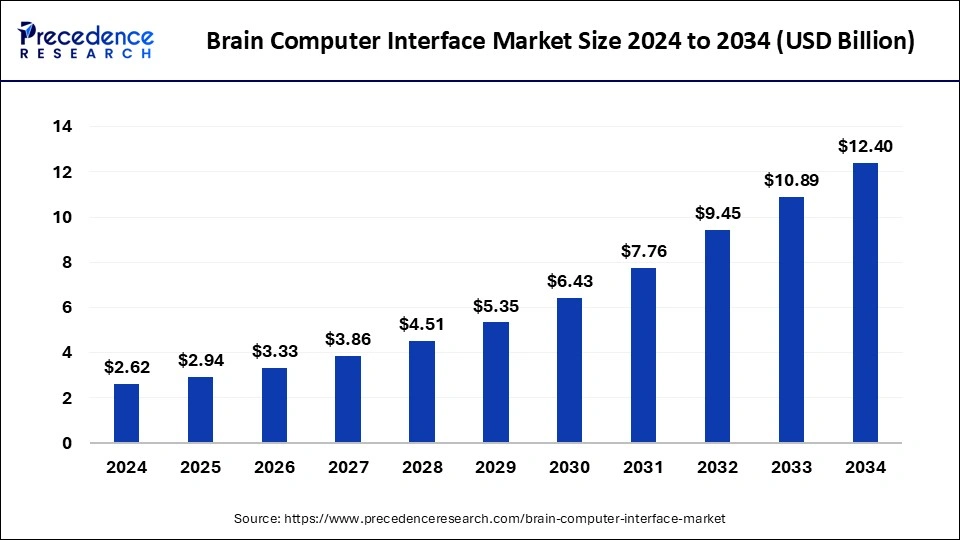
Market Highlights
- North America has accounted revenue share of over 39.84% in 2024.
- By application, healthcare segment has held revenue share of 58.54% in 2024.
- By product, non-invasive brain computer interface segment has generated 81.86% revenue share in 2024.
- By component, hardware segment has captured 63.97% revenue share in 2024.
- By end user, medical segment has garnered 46.41% of the total revenue share in 2024.
Market Size and Forecast
- Market Size in 2025: USD 2.94 Billion
- Market Size in 2026: USD 3.33 Billion
- Forecasted Market Size by 2034: USD 12.40 Billion
- CAGR (2025-2034): 17.35%
- Largest Market in 2024: North America
Market Overview
Brain computer interface market with the developed technologies in the market is also called brain-machine interface. The brain computer interface involves the relation between the brain activity and the connected external devices for example a robot limb or the computer. The brain computer interface with the advanced developed technology in the market for studying the neurodevelopmental problems with the detection of the neuron signal and analysis with the external devices connected.
The brain computer interface allows to of controlling the machines by the brain with the integration of the software and hardware developments with improved facilities and enhance communication between the people and machine with increased utilization of the brain computer interface in the medical sector, for example, electroencephalography. It is mainly utilized in neurogenerative disorder. with improved communication between people and communication and movement disorders.
The impact of the covid -19 on the brain computer interface market developed with reduced new technologies in the market due to the imposition of the lockdown in various regions because of the widespread of the corona virus with increased utilization of the brain computer interface in the geriatric and elderly patients with an increase in growth of the chronic disorders such as Epilepsy, Parkinson's, Alzheimer with enhanced market growth of the brain computer interface with the raised growth rate during the forecast period helps to accelerate the market of brain computer interface.
The increasing potential of the brain computer interface devices specifically in the healthcare industry for the treatment of the neurological disorders is expected to create immense growth opportunities for the market. Furthermore, the rising demand for BCI-enhanced video gaming devices and the expansion of BCI research in the military industry is also expected to support the market growth during the forecast period.
Brain Computer Interface Market Growth Factors
The brain computer interface with the rapid acceptance of the newly developed advanced technologies with boosting the market growth rate during the forecast period. Increased neurodevelopmental problems, and enhanced demands from the customer for improving health conditions which drive the brain computer interface market to a larger extent. The increasing prevalence of chronic disorders such as epilepsy, Parkinson's, and Alzheimer's disorders are seen majorly in geriatric patients with improved application of the brain computer interface in home care applications, problems in brain functioning, raised communication, enriched entertainment, and video gaming help to enhance the market of brain computer interface. Rise in examination and effect technologies with new treatments and raised efficiency and efficacy of the treatment.
The key market players from various companies with raised investment for constant examination and development of the new technologies with new treatment and enhanced efficacy in the brain computer interface help to grow the market with high demands from the customer for new innovations for treating the neurodegenerative disorder and growing utilization of the brain computer interface from the medical sector with increasing the number of the patients with the chronic disorder. Which led to driving the market of brain computer interfaces. The government support and enhance investment for improving the developments in the brain computer interface by raising the infrastructure development and more research and development for the benefit of the people for treating the disorder with improved efficiency and imposed policies from the government such as reimbursement helps to expand the market of brain computer interface to the larger extend during the forecast period.
Market Scope
| Report Coverage | Details |
| Market Size in 2025 | USD 2.62 Billion |
| Market Size in 2026 | USD 3.33 Billion |
| Market Size by 2034 | USD 12.40 Billion |
| Growth Rate from 2025 to 2034 | CAGR of 17.35% |
| Largest Market | North America |
| Fastest Growing Market | Asia Pacific |
| Base Year | 2024 |
| Forecast Period | 2025 to 2034 |
| Segments Covered | Product, Application, Component, End User |
| Regions Covered | North America, Europe, Asia-Pacific, Latin America, and Middle East & Africa |
Market Dynamics
Drivers
- Growing prevalence of neurodegenerative disorder - An increasing number of disorders with neuro-developmental problems with raised problems in interactions, and communication with people. High study and growth with increased efficiency and efficacy of the treatment for improving the health of the patients with the connection of the brain with external devices help to boost the market of brain computer interface during the forecast period.
- A large number of patients belonging to the geriatric population - People with increased chronic disorders such as Parkinson's disorder, Alzheimer's disorder, and Epilepsy with high demands from the customer helps to expand the market of brain computer interface with improved research and development with new technologies in the brain computer interface with increased efficiency of the treatment. Which drives the market of brain computer interfaces with an advanced growth rate.
- Increased research and developmental activities - The advanced developed technologies in the brain computer interface with new treatments with improved efficiency led to enhance the market with increased growth rate. Expanded utilization of the brain computer interface in various applications such as Parkinson's, epilepsy, Alzheimer's, and others with an improved growth rate of the brain computer interface.
Key Market Challenges
- The high cost of the brain computer interface - The advanced developed technologies with new developments introduced in the market with improved efficiency and efficacy of the treatment involved for treating the degenerative disorders with improved connections between the brain and external devices led to the enhanced cost of the treatment. This may hamper the market of the brain computer interface which led to reduced demand and decreased market growth rate due to the high cost of the treatment. It is impossible for the common people to take benefit from the improved treatment for treating the disorder.
- Lack of skill - Introduction of the newly developed advanced technologies in the brain computer interface which require increased knowledge for carrying out the procedure involved in the brain computer interface. Lack of skill to perform the procedure in the brain computer interface may decline the market growth rate of the brain computer interface due to reduced demands.
- Lack of connectivity - Th brain computer interface technology requires increased internet connections to carry out the procedure involved in treating the disorders. Lack of internet connection or low connectivity may stop the workflow because hardware and software with developed technologies are installed in the external devices. Low connectivity may reduce the market growth rate.
Opportunities
- Increased health care facilities - The advanced technologies developed in the brain computer interface market with inflated growth rate due to increasing chronic disorders such as Parkinson's, Epilepsy, and other disorders with improved treatment with boosted efficiency of the treatment help to expand the market to a greater height with an increase in brain computer interface market.
- Increased government support - The Government from various regions with a high acquisition in improving the new technologies in the medical sector for treating the neurodevelopmental disorder with heightened health care facilities provided for the citizens. The government imposed new policies such as reimbursement which helps common people to take benefit of the advanced developed technologies and improved infrastructure of the medical sector helping to drive the market of brain computer interface.
- The key market players - The key market players are the major role players in the brain computer interface with a new introduction of the advanced developed technologies in the brain computer interface with enhanced demands from the customer for the new treatment for treating the neurodegenerative disorders with increased efficiency of the treatment and increased investment from the key market players for continuous research and development in the brain computer interface helps to accelerate the market growth rate to a larger extend.
Segments Insights
Product Insights
On the basis of product, the non-invasive brain computer interface with the largest market growth rate with increased revenue share helps to grow the market of brain computer interface. Owing to the increased utilization of the brain computer interface with improved technology and grown manufacturing and production of the products such as gaming sticks, amplifiers, headsets, and other with increased production according to the newly developed technologies and increased utilization from the customer helps to boost the market of brain computer interface. High research projects with newly introduced technologies in the brain computer interface with lucrative market growth during the forecast period.
In the most extreme circumstances, tetraplegic or post-stroke individuals are physically "locked in" their bodies, unable to exert any motor control following, for example, spinal cord damage or a brainstem stroke, necessitating additional means of communication and control. Non-invasive brain-computer interfaces (BCI) based on electroencephalograms (EEG) can be identified by the method used to monitor brain activity and by the method by which various brain signals are converted into instructions that operate an effector—for instance, controlling a computer cursor for word processing and accessing the internet).
Non-invasive EEG-based BCIs enable motor control restoration in patients with spinal cord injuries and strokes, as well as brain-derived communication in those with amyotrophic lateral sclerosis. The brain activity of people with epilepsy and attention deficit hyperactivity disorder could be downregulated. The recent rapid advancements in computer processing rates and signal analysis methods, along with the new concepts related to clinical neurorehabilitation of severely disabled patients, will soon result in practical clinical applications.
The most often used non-invasive modality in BCIs is EEG, which allows for the elicitation of several control signals, including SCP, SSVEP, MI, ErrP, and P300. Additionally, most BCI researchers favor the non-invasive approach to avoid the chance of surgery. The often-used non-invasive modalities include EEG, PET, MEG, fNIRS, and fMRI. The choice of measurement technique is influenced by some factors, including cost, portability, invasiveness, measured activity, temporal resolution, spatial resolution, and others.
EEG is the most widely used neuroimaging modality among BCI researchers because of its advantageous characteristics, including low cost, high temporal resolution, non-invasiveness, and mobility. The adoption of BCI applications in Industry 4.0 might theoretically help to reclaim the operator as the focal point of industrial processes. The following categories could be used to group potential industrial applications: workplace safety, specialized instruction, and device management.
The invasive segment also with increasing CAGR of the market with improved developments for treating neurodegenerative disorders and a significant rise in the market growth of brain computer interfaces.
Brain Computer Interface Market Revenue, By Product, 2022-2024 (USD Million)
| Product | 2022 | 2023 | 2024 |
| Invasive Brain Computer Interface | 202.9 | 224.7 | 250.3 |
| Partially Invasive Brain Computer Interface | 181.2 | 201.5 | 225.3 |
| Non-Invasive Brain Computer Interface | 1,745.8 | 1,928.1 | 2,141.4 |
Applications Insights
Based on applications, the healthcare sector accounts for the largest market growth in the brain computer interface with an increasing number of patients with the chronic disorder such as epilepsy, Parkinsons', and others with expanded treatment and improved efficiency of the therapy involved drives the market of brain computer interface due to high demands from the customer. Increased applications due to increased technology in treating paralytic patients, neurodegenerative disorders, and others help to expand the market of brain computer interfaces with an enhanced growth rate during the forecast period.
Brain signals have a wide range of potential uses in the medical industry, including prevention, detection, diagnosis, rehabilitation, and restoration. The majority of fatalities and serious injuries are caused by vehicle accidents. Research in several domains has focused on determining their causes in order to prevent them in the future. Additionally, the ability of brain-computer interface systems to monitor mental state has also aided in the prediction and detection of health problems like seizure disorders (epilepsy), abnormal brain structure (brain tumors), brain swelling (encephalitis), and sleep disorders (narcolepsy).
According to the WHO, a sizable share of people suffers from illnesses and conditions that limit their ability to engage in physical activity. Similar to this, the majority of people cannot receive the desired care. The main goal of creating the Brain-Computer Interface (BCI) is to give persons with neuromuscular disabilities such as stroke, cerebral palsy, multiple sclerosis, amyotrophic lateral sclerosis, or spinal cord injury a resource tool to manage daily activity. According to estimates, 250,000 and 500,000 persons worldwide experience spinal cord injuries (SCI) each year. These injuries are linked to reduced rates of economic involvement and place a significant cost on society.
Brain Computer Interface Market Revenue, By Application, 2022-2024 (USD Million)
| Application | 2022 | 2023 | 2024 |
| Healthcar | 1,248.4 | 1,377.5 | 1,528.6 |
| Smart Home Control | 129.8 | 146.8 | 166.9 |
| Communication And Control | 522.8 | 574.4 | 634.6 |
| Entertainment & Gaming | 229.0 | 255.6 | 286.9 |
Components Insights
On the basis of components, the software component with the highest market growth in the brain computer interface which require enhance connectivity, embedded systems, Internet of things developed for carrying out the procedure involved in treating the disorders helps to boost the market growth rate of brain computer interface.
Hardware
A cap with conductors that monitor brain activity that can be felt on the scalp is frequently needed for wearable BCI. A wearable BCI may be suitable for activities like gaming, managing an industrial robot, and augmented and virtual reality. The majority of wearable BCIs assess the electrical activity of the brain using electroencephalography (EEG). Functional near-infrared spectroscopy, a new technique, measures blood flow by shining near-infrared light through the skull, which can reveal details like the user's goals.
Many players are providing BCI hardware, for instance, NEURABLE unveiled these brand-new BCI headphones in April 2021, providing users with knowledge of how their brains function. The programmed helps users manage their time by suggesting break periods to maintain attention throughout the day.
Neurotechnology launch the Development Kit BrainAccess in August 2020 for use in projects involving brain-computer interfaces. The kit includes the headgear, electrodes, EEG signal acquisition, electroencephalograph, processing software, and example brain-computer interface (BCI) algorithms. It provides a complete dry-contact electroencephalography (EEG) solution.
A Brain-computer Interface Joint Laboratory will be developed by Huami Technology and the Institute of Advanced Technology, University of Science and Technology of China (USTC-IAT), utilizing Huami Technology's innovative positive aspects in the field of smart electronics wearables and research advantages in BCI, to make advancements in advanced technologies and create a new framework for beneficial health. An advanceable and practical system and neurofeedback platform for individuals in the domains of information technology, engineering neuroscience, and healthcare was introduced by Naxon Labs in May 2020 under the name Explorer, these tools significantly boom the hardware segment.
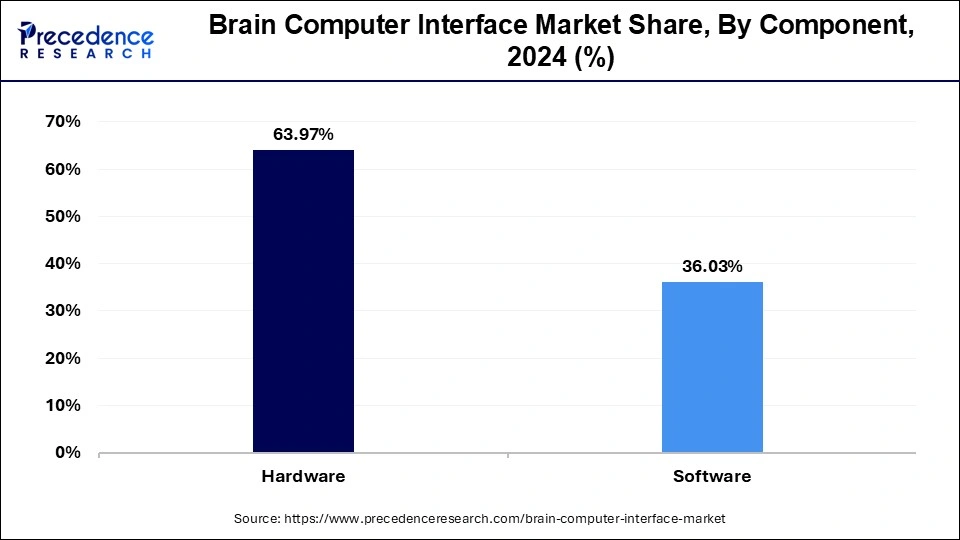
Software
Software tools allow researchers the flexibility to work at both the user level and the programming level (application development) (acquire, visualize, and export data). Additionally, it has simple interaction with offline data analysis tools based on MATLAB, Python, and other programming languages as well as real-time third parties based on Lab Streaming Layer LSL.
Software platforms are created for three purposes:
- Streamlining the synchronized data collection and biometrics analysis for human behavior research;
- Improving cognitive function in health and wellness;
- Accelerating the design and coding of real-time neuroscientific or brain-computer interface applications.
For instance, A toddler with telekinetic abilities serves as the main character in the brain-controlled game Awakening, which was developed by the Boston-area business Neurable. The figure must do mental gymnastics to pick up objects like a balloon dog and rainbow rings to escape from a laboratory. A headband with electrodes that connects to a virtual reality headset is worn by players. Software intercepts and analyses their brain impulses to decide how the character will move. So that they can pick up the toys, players can educate their brains to send the appropriate signals.
Moreover, many software plays a vital role in BCI such as an accessible (AGPLv3) platform called OpenViBE is designed exclusively for BCI experiments. It offers a graphic user interface with "blocks" you may use to construct experiments. Python, C++, Lua, or MATLAB can all be used to enhance these blocks. Due to its focus on BCI development, it offers substantial support for uploading EEG data from numerous devices and a large number of algorithms designed exclusively for BCIs. Additionally, it features cool 3D interfaces for experimenting with BCI paradigms, such as raising a spaceship via motor imagery. Cognixion, a computer software business that specializes in biotechnology, machine learning, and artificial intelligence, has raised around $15 million in funding, most significantly from Amazon Alexa Fund. The software developed by Cognixion includes a sensory communication device that allows users to converse using a BCI that converts brainwaves into speech.
End User Insights
The end-user, medical segments account for the highest growth with increasing the CAGR of the brain computer interface with enhanced utilization of the developed technology due to growing chronic disorders such as neurodegenerative disorders with improved efficiency and efficacy of the developed treatment helps to grow the market of brain computer interface with enhanced revenue share in the medical sector. Which accelerates the market growth rate to a greater height. The military segment also with the highest market growth rate during the forecast period with enhanced research and development activities strives the market growth rate of brain computer interface due to increased demands.
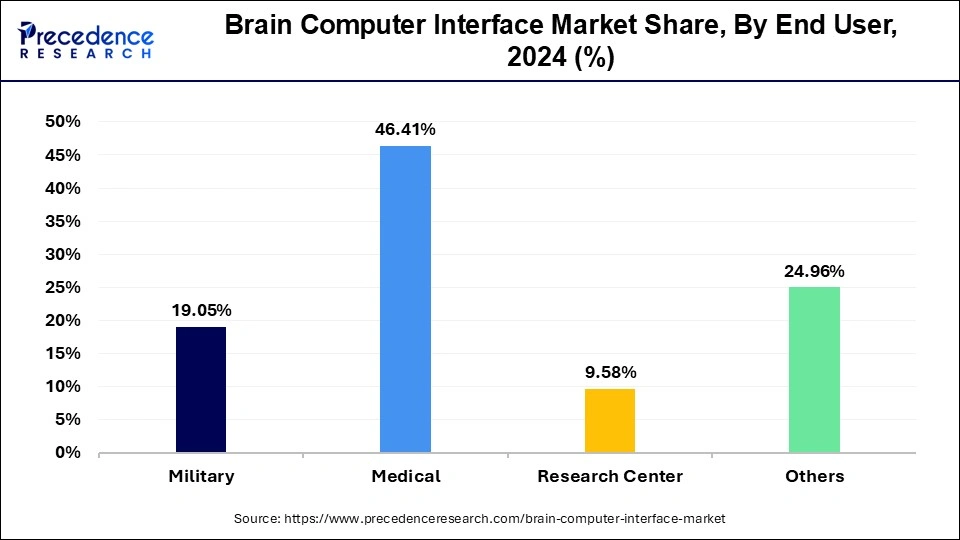
BCI is being developed to help patients who have lost sensory and motor function, such as those who have experienced paralysis due to a spinal cord injury or stroke. These comprise devices that give users of assistive technology the ability to operate wheelchairs, mechanical limbs, and exoskeletons. Additionally, BCIs are being created for those who have lost their capacity to talk. These function by converting the patient's purposefully created brain activity into synthesized speech or text. However, research settings have primarily been the only ones where decoded brain activity has been used to enable control of assistive technology. Future advances will probably call for more innovation. The Brain-Computer Interface (BCI) technology is a potent tool for user and system communication. To provide commands and finish the interaction, there are no additional hardware requirements or physical movements needed. BCIs were initially created by the research community with biomedical uses in mind, which resulted in the creation of assistive technology. They have made it easier for physically disabled or locked-in individuals to regain their capacity to move around and replace lost motor functioning. The scientific community has been inspired to investigate how BCI interacts with non-paralyzed persons through medical applications by the positive future forecast for BCI.
BCIs can be used to improve treatments by giving more knowledge about how the brain works. BCI can detect abnormal brain activity and use it to spot the beginning of symptoms. The requirement for professionals to routinely re-program devices could be reduced if treatment could be customized for a particular patient. One example of a responsive implanted device that uses brain stimulation to stop epileptic seizures from happening is the NeuroPace RNS75, which has been approved for clinical usage in the US. Neurostimulation therapies for mental health conditions like depression may become more responsive to the patient's mental state with the use of BCI.
Brain Computer Interface Market Revenue, By End User, 2022-2024 (USD Million)
| End User | 2022 | 2023 | 2024 |
| Military | 401.9 | 446.6 | 499.1 |
| Medical | 984.0 | 1,090.4 | 1,215.0 |
| Research Center | 204.1 | 225.9 | 251.3 |
| Others | 539.9 | 591.5 | 651.5 |
Regional Insights
U.S. Brain Computer Interface Market Size and Growth 2025 to 2034
The U.S. brain computer interface market size is evaluated at USD 617.60 million in 2025 and is projected to be worth around USD 2,716.30 million by 2034, growing at a CAGR of 17.89% from 2025 to 2034.
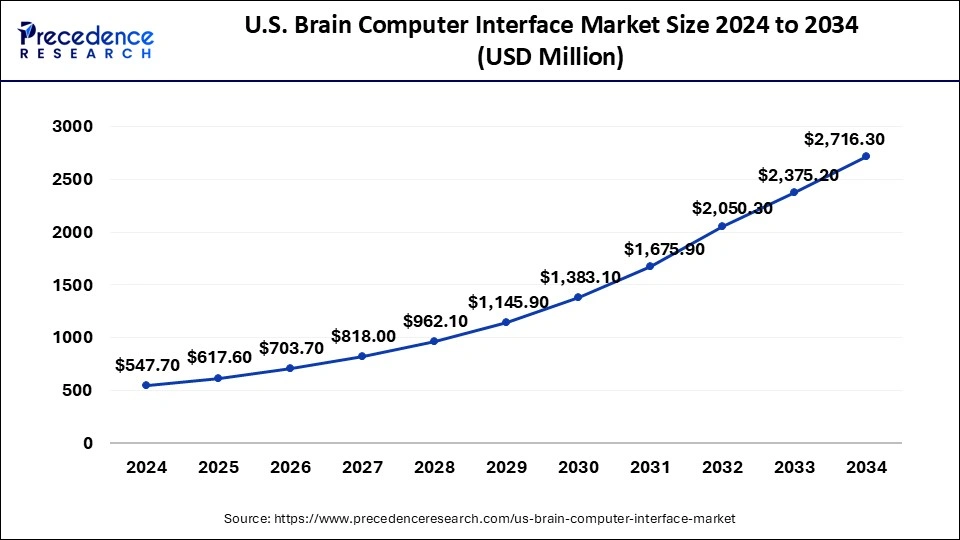
The geographical segment, North America dominates with the largest market growth rate due to growth analysis and expansion activities in the brain computer interface with advanced treatments introduced for treating chronic disorders, and the expanded effect tends to propel the market of brain computer interface.
North American countries are extensively engaged in R&D and clinical trial studies in the brain-computer interface (BCI) technology. High R&D expenditure, development of advanced infrastructure, and proper utilization of advanced technology are some of the prominent factors thriving the growth of brain computer interface market across the North America region. Additionally, the increasing prevalence of neurological diseases in this area, including Alzheimer's, Huntington's disease, and Parkinson's is likely to augment the market growth. Furthermore, the rising popularity and demand for realistic gaming is likely to thrive with the advancement of innovative technology like enhanced brain-computer interfaces, which further accelerates the adoption of BCI technologies in the U.S., Canada, and other North American countries.
Moreover, the rising number of BCI startup firms across the U.S. is bolstering the growth of the brain computer interface market in the North America region brain co. For instance, there were more than 87 brain computer interface startups across the U.S. as reported in September 2022. Some of the startups operating in the field of BCI across the U.S. are Ceribell, Neuralink, Paradromics, Feelmore Labs, Cognixion, Neurable, and many others. The increasing number of product launches by such emerging startup companies related to the brain computer interface is substantially boosting the market growth in the United States.
Brain Computer Interface Market Instances
- Synchron, a startup that specializes in endovascular brain-computer interface (BCI), launched the first human BCI implant in the United States in July 2022.
- Feelmore Labs introduced their product name Cove, a wearable device that has been clinically tested to decrease stress levels and improves sleep quality in New York in July 2020.
Besides, rising government support for the development of advanced brain computer interface solutions is burgeoning the growth of markets in this region.
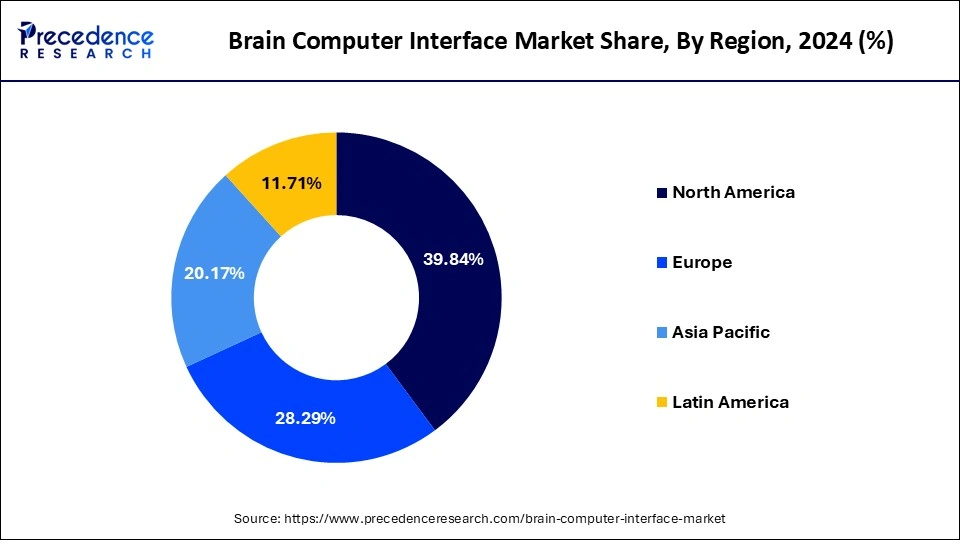
The government with increased backup and providing investments for ongoing analysis and development for new introductions and technologies with raised policies such as restitution helps to grow the market growth rate of brain computer interface during the forecast period. Rising government support and extensive research conducted for the discovery of treatment solutions associated with brain injuries and illness are major driving factors for the growth of brain computer interface market in the Asia Pacific region. Rising healthcare expenditure, development of advanced infrastructure, and increasing patient awareness about advanced healthcare solutions are some of the major reasons for the growth of brain computer interface market in the Asia Pacific region. Additionally, the availability of low-cost manufacturing sites and attractive taxation regulations have encouraged global businesses to participate in this profitable sector in Asian countries. This has substantially fostered the growth of brain computer interface market in this region.
Furthermore, the rising number of collaborations among BCI market players across Asia Pacific region is ultimately evolving the growth of the brain computer interface market. For instance, Neuroleap, India's applied neuroscience firm, inked an MoU with the Indian Institute of Technology Palakkad to boost research in Brain Computer Interface (BCI) technology for neuroenhancement and neurorehabilitation, in July 2019. Moreover, the increased expenditure on R&D and the rising number of product launches are significant factors enriching the growth of BCI market in this region. For instance, scientists at the Korea Advanced Institute of Science and Technology created a brainmachine interface that can operate robotic hands just by thinking, in October 2022.
Brain Computer Interface Market Companies
- Openbci
- Nihon Kohden Corporation
- Neuroky
- Natus Medical Incorporated
- Integra Lifesciences
- G.Tec Medical Enginneering Gmbh
- Emotiv
- Cortech Solutions
- Cadwell Industries
- Advanced Brain Monitoring, Inc
- Mind Technologies, Inc
- Covidien, Plc
- Compumedics, Ltd
- Cas Medical Systems
- Others
Recent Development
- In the year 2021 November, The Company NeuraMatrix of brain computer interface with the completion of CNY 100 million in finance. By the end of the year production of the system on the chip was first anticipated with mass production.
- In the year 2021 October, the EMOTIV launcher and improved enhancements to the EmotivPRO Suite 3.0. introduced by the EMOTIV with improved solutions in neuroscience.
Segments Covered in the Report
By Product
- Invasive Brain Computer Interface
- Partially Invasive Brain Computer Interface
- Non-Invasive Brain Computer Interface
By Application
- Healthcare
- Entertainment & Gaming
- Communication & Control
- Smart Home Control
- Brain Function Repair
- Disabilities Restoration
By Component
- Hardware
- Software
By End User
- Military
- Medical
- Manufacturing
- Research Center
- Others (Gaming and Communication)
By Region
- North America
- Europe
- Asia-Pacific
- Latin America
- Middle East & Africa (MEA)
For inquiries regarding discounts, bulk purchases, or customization requests, please contact us at sales@precedenceresearch.com
Frequently Asked Questions
Ask For Sample
No cookie-cutter, only authentic analysis – take the 1st step to become a Precedence Research client
 sales@precedenceresearch.com
sales@precedenceresearch.com
 +1 804-441-9344
+1 804-441-9344